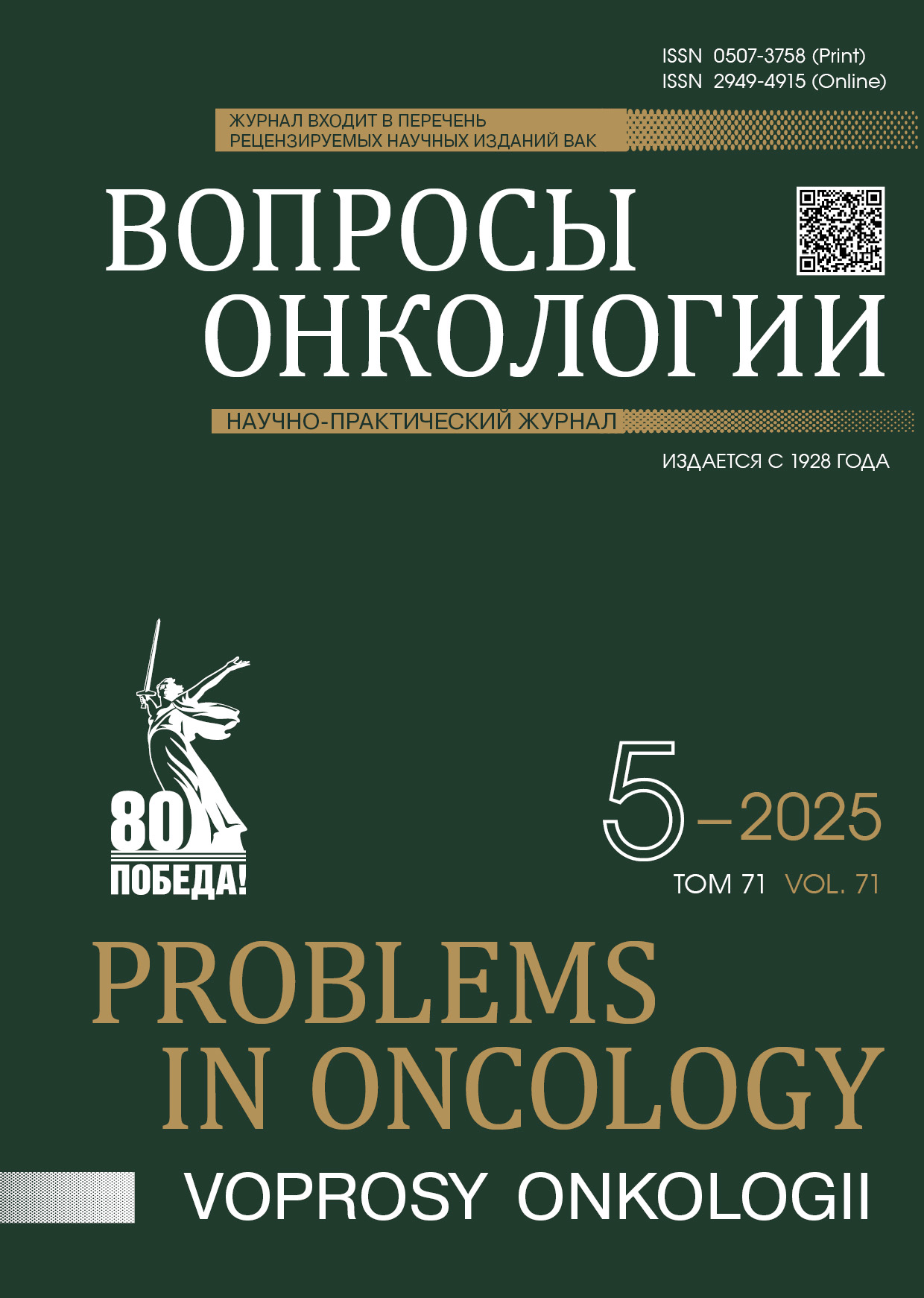Abstract
Introduction. Skull base chordomas and chondrosarcomas are rare, radioresistant tumors characterized by high rates of local recurrence and requiring multidisciplinary management. Scanning beam proton therapy has historically been regarded as the optimal radiation modality for these neoplasms.
Aim. To evaluate the efficacy and safety of scanning beam proton therapy for skull base chordomas and chondrosarcomas.
Materials and Methods. The study included patients with skull base chordomas or chondrosarcomas treated with proton therapy using the Prometheus proton therapy system at the A. Tsyb Medical Radiological Research Center. Treatment plans were developed using ProtomTherapyPlanner software (versions 1.12–2.14) with Monte Carlo algorithm optimization. Outcomes assessed included overall survival, local control, and treatment toxicity. Tumor response was evaluated according to RECIST 1.1 criteria, and toxicity was graded using CTCAE v5.0.
Results. Between 2016 and 2024, 62 patients with chordoma (n = 46) and chondrosarcoma (n = 16) were enrolled. Median follow-up was 3 years. The median gross tumor volume (GTV) was 23 cm³ (IQR 12–39), and the median total radiation dose delivered was 70 GyRBE (range 64–74 GyRBE). Overall survival rates at 1 and 3 years were 98.4 and 94.1 %, respectively. Local control rates were 100 % during the 1st year and 77.9 % during the 3d year. Patients with ECOG performance status 0–1 demonstrated significantly better survival and local control outcomes (p < 0.05). Lower local control rates were observed in non-operated patients and those with tumors adjacent to the brainstem. Severe (grade ≥ 3) radiation complications occurred in 1.6 % of patients.
Conclusion. Scanning beam proton therapy achieved high overall survival and local control rates with minimal toxicity. Optimal outcomes were observed in patients with good performance status (ECOG 0-1) receiving combined modality treatment. Tumor proximity to the brainstem was associated with reduced local control.
References
Mizerny B.R., Kost K.M. Chordoma of the cranial base: the McGill experience. J Otolaryngol. 1995; 24(1): 14-9.
Lee S.Y., Lim Y.C., Song M.H., et al. Chondrosarcoma of the head and neck. Yonsei Med J. 2005; 46(2): 228-32.-DOI: https://doi.org/10.3349/ymj.2005.46.2.228.
Biermann J.S., Hirbe A., Ahlawat Sh., et al. Bone cancer. NCCN Guidelines: NCCN. 2025; version 2.2025: 53-57.-URL: https://www.nccn.org/professionals/physician_gls/pdf/bone.pdf.
Casali P.G., Bielack S., Abecassis N., et al.; ESMO Guidelines Committee, PaedCan and ERN EURACAN. Bone sarcomas: ESMO-PaedCan-EURACAN Clinical Practice Guidelines for diagnosis, treatment and follow-up. Ann Oncol. 2018; 29(Suppl 4): 79-95.-DOI: https://doi.org/10.1093/annonc/mdy310.
Tzortzidis F., Elahi F., Wright D., et al. Patient outcome at long-term follow-up after aggressive microsurgical resection of cranial base chordomas. Neurosurgery. 2006; 59(2): 230-7.-DOI: https://doi.org/10.1227/01.neu.0000223441.51012.9d.
Samii A., Gerganov V., Herold C., et al. Surgical treatment of skull base chondrosarcomas. Neurosurg Rev. 2009; 32: 67-75.-DOI: https://doi.org/10.1007/s10143-008-0170-4.
Tzortzidis F., Elahi F., Wright D.C., et al. Patient outcome at long-term follow-up after aggressive microsurgical resection of cranial base chondrosarcomas. Neurosurgery. 2006; 58: 1090-8.-DOI: https://doi.org/10.1227/01.neu.0000215892.65663.54.
Sekhar L.N., Pranatartiharan R., Chanda A., et al. Chordomas and chondrosarcomas of the skull base: Results and complications of surgical management. Neurosurg Focus. 2001; 10: 1-4.-DOI: https://doi.org/10.3171/foc.2001.10.3.3.
Almefty K., Pravdenkova S., Colli B.O., et al. Chordoma and chondrosarcoma: similar, but quite different, skull base tumors. Cancer. 2007; 110(11): 2457-67.-DOI: https://doi.org/10.1002/cncr.23073.
Weber D.C., Rutz H.P., Pedroni E.S., et al. Results of spot-scanning proton radiation therapy for chordoma and chondrosarcoma of the skull base: The Paul Scherrer Institut experience. Int J Radiat Oncol Biol Phys. 2005; 63: 401-9.-DOI: https://doi.org/10.1016/j.ijrobp.2005.02.023.
Ares C., Hug E.B., Lomax A.J., et al. Effectiveness and safety of spot scanning proton radiation therapy for chordomas and chondrosarcomas of the skull base: first long-term report. Int J Radiat Oncol Biol Phys. 2009; 75(4): 1111-8.-DOI: https://doi.org/10.1016/j.ijrobp.2008.12.055.
Weber D.C., Malyapa R., Albertini F., et al. Long term outcomes of patients with skull-base low-grade chondrosarcoma and chordoma patients treated with pencil beam scanning proton therapy. Radiother Oncol. 2016; 120(1): 169-74.-DOI: https://doi.org/10.1016/j.radonc.2016.05.011.
Hug E.B., Loredo L.N., Slater J.D. Proton radiation therapy for chordomas and chondrosarcomas of the skull base. J Neurosurg. 1999; 91(3): 432-9.-DOI: https://doi.org/10.3171/jns.1999.91.3.0432.
Munzenrider J.E., Liebsch N.J. Proton therapy for tumors of the skull base. Strahlenther Onkol. 1999; 175(S2): 57-63.-DOI: https://doi.org/10.1007/bf03038890.
Stacchiotti S., Sommer J. Building a global consensus approach to chordoma: A position paper from the medical and patient community. Lancet Oncol. 2015; 16(2): 71-83.-DOI: https://doi.org/10.1016/S1470-2045(14)71190-8.
Palm R.F., Oliver D.E., Yang G.Q., et al. The role of dose escalation and proton therapy in perioperative or definitive treatment of chondrosarcoma and chordoma: an analysis of the National Cancer Data Base. Cancer. 2019; 125(4): 642-51.-DOI: https://doi.org/10.1002/cncr.31958.
Holtzman A.L., Bates J.E., Morris C.G., et al. Impact of type of treatment center and access to care on mortality and survival for skull base chordoma and chondrosarcoma. J Neurol Surg B Skull Base. 2021; 83(3): 328-38.-DOI: https://doi.org/10.1055/s-0040-1722228.
Liu H., Chang J.Y. Proton therapy in clinical practice. Chin J Cancer. 2011; 30(5): 315-26.-DOI: https://doi.org/10.5732/cjc.010.10529.
Stacchiotti S., Sommer J., et al. Building a global consensus approach to chordoma: a position paper from the medical and patient community. Lancet Oncol. 2015; 16(2): e71-83.-DOI: https://doi.org/10.1016/S1470-2045(14)71190-8.
Валиев А.К., Тепляков В.В., Мусаев Э.Р., et al. Практические рекомендации по лечению первичных злокачественных опухолей костей. Злокачественные опухоли. 2022; 12(3s2): 323-325.-DOI: https://doi.org/10.18027/2224-5057-2022-12-3s2-307-329.-URL: https://rosoncoweb.ru/standarts/RUSSCO/2022/2022-17.pdf. [Valiev A.K., Teplyakov V.V., Musaev E.R., et al. Practical recommendations for the treatment of primary malignant bone tumors. Malignant tumors. 2022; 12(3s2): 323-325.-DOI: https://doi.org/10.18027/2224-5057-2022-12-3s2-307-329.-URL: https://rosoncoweb.ru/standarts/RUSSCO/2022/2022-17.pdf (In Rus)].
Gordon K., Gulidov I., Koryakin S., et al. Proton therapy with a fixed beamline for skull-base chordomas and chondrosarcomas: outcomes and toxicity. Radiat Oncol. 2021; 16(1): 238.-DOI: https://doi.org/10.1186/s13014-021-01961-9.
Lemaeva A., Gulidov I., Smyk D., et al. A single-center experience of the upright proton therapy for skull-base chordomas and chondrosarcomas: Updated results. Clin Transl Radiat Oncol. 2024; 48: 100814.-DOI: https://doi.org/10.1016/j.ctro.2024.100814

This work is licensed under a Creative Commons Attribution-NonCommercial-NoDerivatives 4.0 International License.
© АННМО «Вопросы онкологии», Copyright (c) 2025

